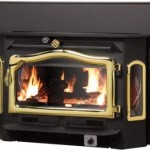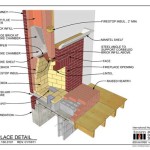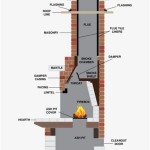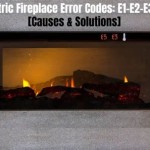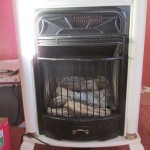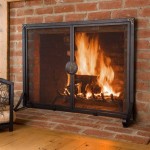High Efficiency Gas Fireplace Insert: A Comprehensive Guide
A gas fireplace insert is a self-contained unit designed to be installed within an existing masonry or factory-built fireplace. It offers an efficient and convenient alternative to traditional wood-burning fireplaces. High-efficiency models, in particular, are engineered to maximize heat output while minimizing fuel consumption, contributing to both cost savings and environmental responsibility.
These inserts operate by burning natural gas or propane to generate heat. This heat is then distributed into the room through a combination of radiant heat, which warms objects directly in its path, and convection heat, which circulates heated air throughout the space. The efficiency of a gas fireplace insert is measured by its Annual Fuel Utilization Efficiency (AFUE) rating. A higher AFUE indicates a greater percentage of fuel is converted into usable heat, rather than being lost up the chimney.
Choosing a high-efficiency gas fireplace insert involves considering several factors, including heating needs, venting requirements, aesthetic preferences, and budget. Understanding the different types of inserts available, their features, and the installation process is crucial for making an informed decision.
Understanding the Benefits of High Efficiency
High-efficiency gas fireplace inserts provide a range of benefits compared to traditional wood-burning fireplaces and older, less efficient gas models. These advantages stem from their improved design and combustion technology, leading to substantial improvements in performance and overall value.
One of the primary benefits is reduced heating costs. Due to their high AFUE ratings, these inserts consume less fuel while generating more heat. This translates directly into lower monthly gas bills, particularly during the colder months. The savings can be significant, especially when replacing a traditional wood-burning fireplace, which often loses a substantial amount of heat up the chimney.
Furthermore, high-efficiency gas fireplace inserts offer improved air quality. Unlike wood-burning fireplaces that release smoke and particulate matter into the air, gas inserts burn cleanly, producing minimal emissions. This is particularly beneficial for individuals with respiratory sensitivities and contributes to a healthier indoor environment. Many models are EPA-certified, meeting stringent emission standards.
Convenience is another notable advantage. Gas fireplace inserts eliminate the need to chop, store, and haul firewood. They also eliminate the mess associated with ashes and soot. With the push of a button or the flip of a switch, the fireplace can be ignited and extinguished. Many models come equipped with thermostats and remote controls, allowing for precise temperature control and added convenience.
Finally, many high-efficiency gas fireplace inserts offer enhanced safety features. They are designed with sealed combustion chambers, preventing dangerous carbon monoxide from entering the home. They also often include safety features such as automatic shut-off mechanisms and overheat protection, minimizing the risk of accidents.
Factors to Consider When Choosing an Insert
Selecting the right high-efficiency gas fireplace insert involves carefully evaluating several factors to ensure it meets specific heating needs and aesthetic preferences. A thorough assessment of these factors will contribute to a satisfactory and long-lasting solution.
The first crucial consideration is the size of the space to be heated. Gas fireplace inserts are rated by their BTU (British Thermal Unit) output, which indicates the amount of heat they can generate per hour. A larger room requires a higher BTU rating to effectively heat the space. Choosing an insert with an insufficient BTU rating will result in inadequate heating, while selecting one with an excessively high BTU rating may lead to overheating and inefficient operation. Assessing the room's square footage, insulation levels, and climate is essential for determining the appropriate BTU output.
Venting requirements are another critical consideration. Gas fireplace inserts typically require either a direct vent or a B-vent system. Direct vent systems draw combustion air from outside and exhaust exhaust gases directly outdoors through a sealed vent pipe. This type of venting is highly efficient and safe, as it prevents the backdrafting of combustion products into the home. B-vent systems, on the other hand, rely on the existing chimney to exhaust combustion gases. B-vent systems are typically less expensive to install, but they are also less efficient and may require modifications to the existing chimney to ensure proper ventilation. The choice between a direct vent and a B-vent system will depend on the existing chimney configuration and local building codes.
Aesthetics also play a significant role in the selection process. Gas fireplace inserts are available in a wide range of styles, finishes, and designs to complement different home decors. Options include traditional log sets, contemporary glass beads, and realistic flame patterns. The choice of aesthetic will depend on personal preferences and the overall style of the room. Viewing the insert in person or reviewing detailed images and videos can assist in making an informed decision.
Finally, budget is an important factor to consider. The cost of a high-efficiency gas fireplace insert can vary significantly depending on the model, features, and installation costs. It is important to establish a budget and compare different models within that price range. Obtaining quotes from multiple installers is recommended to ensure a competitive price for the installation process. Considering the long-term cost savings associated with high-efficiency operation is also crucial when evaluating the overall value proposition.
Installation and Maintenance
Proper installation and regular maintenance are vital for ensuring the safe and efficient operation of a high-efficiency gas fireplace insert. Adhering to manufacturer's instructions and local building codes is paramount throughout the process.
Installation should be performed by a qualified and licensed professional. A professional installer possesses the expertise and experience to ensure the insert is installed correctly, the venting system is properly connected, and the gas connections are leak-free. Improper installation can lead to safety hazards, such as gas leaks, carbon monoxide poisoning, and fire. Attempting to install the insert without professional assistance is strongly discouraged.
The installation process typically involves inspecting the existing fireplace and chimney, preparing the opening for the insert, installing the venting system, connecting the gas lines, and testing the operation of the insert. The installer will also ensure the insert meets all applicable building codes and regulations. A thorough inspection of the installation is crucial to verify its safety and functionality.
Regular maintenance is essential for prolonging the lifespan of the gas fireplace insert and maintaining its efficiency. Annual inspections should be performed by a qualified technician to clean the burner assembly, inspect the venting system, and check for any signs of wear or damage. The glass door should be cleaned regularly with a non-abrasive cleaner to remove soot and grime. The log set or glass beads should also be inspected periodically and repositioned as needed to maintain a realistic flame pattern.
In addition to professional maintenance, homeowners can perform some basic maintenance tasks themselves. These include cleaning the area around the fireplace insert, checking the batteries in the remote control, and ensuring the air vents are clear of obstructions. Promptly addressing any unusual noises, smells, or performance issues is crucial for preventing further damage and maintaining safe operation. Consulting the manufacturer's instructions for specific maintenance recommendations is essential.
By following proper installation procedures and adhering to a regular maintenance schedule, homeowners can ensure their high-efficiency gas fireplace insert operates safely and efficiently for many years to come, providing warmth, comfort, and cost savings.

High Efficiency Inserts Fireplaces In Calgary Hearth Home

E33 High Efficiency Gas Fireplace Insert Regency
.aspx?strip=all)
Top 11 Gas Fireplace Insert Trends Of 2024

High Efficiency Fireplace Inserts Vancouver Gas Fireplaces

Gas Fireplace Inserts Pros And Cons Of Ventless Fireplaces

Gas Fireplace Inserts Hvac Seattle Snohomish Skagit County Sun Energy Services

Liberty Lri4e High Efficient Medium Gas Insert Fireplace S Hearth Home

Best Gas Fireplace Inserts Fireplaces Direct Learning Center

Regency Energy Large E33 High Efficiency Gas Inserts Fireplace Toronto Home Comfort

Freestanding High Efficiency Direct Vent Gas Fireplaces Inserts Stoves Godby Hearth And Home
Related Posts

